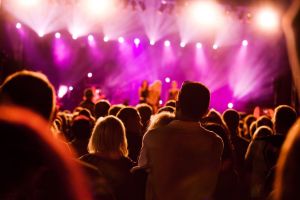For several years ProtectEar has been outfitting stars and musicians with custom molded hearing protection.
From Oscar-winning actors to top box office stars and Grammy-winning musicians, those who value their hearing the most wear custom hearing protection by Custom Protect Ear. See Celebrities.
In essence, all musicians should value their hearing and understand the long term ramifications of being exposed to high-frequency noise over long periods of time. Hearing Health and Preservation is an important part to Music Education.
 Music Noise Exposure
Music Noise Exposure
Studies suggest musicians are four times more likely than others to experience hearing loss due to their repeated exposure to loud, prolonged rehearsals and performances.
Dr. Greg Horton, an audiologist at Rochester Hearing and Speech Center, understands this from his own experience. He’s played drums and bass for various bands over the past twenty years. He remembers attending a Ramones concert when he was 17.
“My ears were ringing for a week afterward and I felt like I had cotton stuffed in my ears,” he said. “I saw other people at the show wearing earplugs and I thought, ‘Hey, that’s probably a good idea,’ but nobody told me that was what I should do.”
Horton stresses that education is a key component of hearing preservation. He encourages music educators, those who give lessons, teach in schools or organize music camps, to incorporate information about it in their curriculum.

For instance, musicians may reject the idea of wearing earplugs because they don’t want to hear a low-quality version of what they’re playing. What they may not know is, there are earplugs specifically designed to filter music while maintaining the fidelity like the dB Life™ Sweet Tones Musicians Earpieces. ThedB Life™ Sweet Tones reduces all frequencies equally by 9 dB, 15 dB, 20 dB or 25 dB with corresponding Flat Attenuation Filters.
This hearing protection is designed for musicians who want to hear sound without distortion but with less volume. Also recommended for those with some hearing loss for use as hearing protection in the 20 dB style. Learn More
“So, for example, my band…we’re a pretty loud band,” Horton explained. “At practice, I use the strongest filters – meaning they will attenuate, turn down, the most. And then, when I play live, I switch out my filters and I play for a shorter period of time and I like to hear a little bit more of the music but it still keeps me safe.”
Hearing Loss Prevention
It’s much easier to prevent hearing loss than it is to treat it, and Horton says it’s not just musicians who’ve been playing a long time who should be aware of this.
“Because we’re seeing that this generation of young adults is having far more incidents of hearing loss than the previous generations for the same age group,” he said, “and it’s all about recreational noise exposure, whether it’s going to concerts, going to clubs, and definitely from all the excessive earbud use.”
He suggests that musicians give their ears a rest once in a while and also recommends a baseline hearing evaluation and annual follow-ups with a licensed audiologist.“We’re an industry that’s not regulated,” Horton said. “We don’t have OSHA coming in saying, ‘Oh, you’re a drummer in a rock n’ roll band? You have to wear your hearing protection,’ so it’s really up to us to do it ourselves.”
SOURCE
Read Article
https://www.wxxinews.org/post/hearing-preservation-should-be-part-music-education



